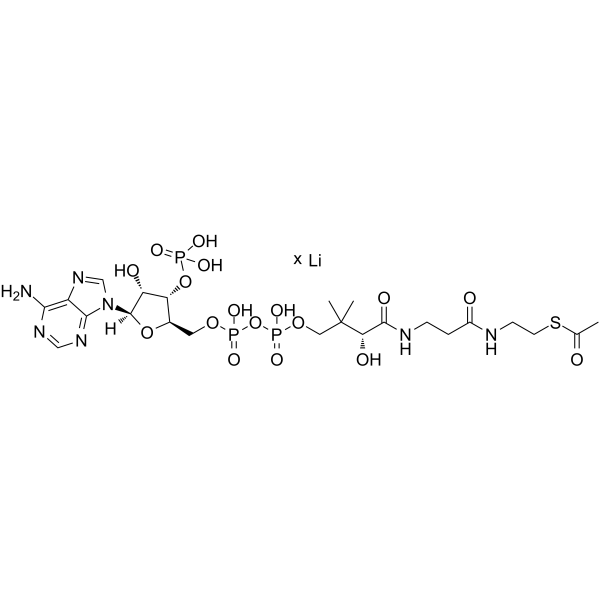Acetyl coenzyme A lithium

Acetyl coenzyme A lithium structure
|
Common Name | Acetyl coenzyme A lithium | ||
|---|---|---|---|---|
| CAS Number | 32140-51-5 | Molecular Weight | 827.37000 | |
| Density | N/A | Boiling Point | N/A | |
| Molecular Formula | C23H35Li3N7O17P3S | Melting Point | N/A | |
| MSDS | Chinese USA | Flash Point | N/A | |
| Symbol |

GHS07 |
Signal Word | Warning | |
Use of Acetyl coenzyme A lithiumAcetyl-coenzyme A (Acetyl-CoA) lithium is a membrane-impermeant central metabolic intermediate, participates in the TCA cycle and oxidative phosphorylation metabolism. Acetyl-coenzyme A lithium, regulates various cellular mechanisms by providing (sole donor) acetyl groups to target amino acid residues for post-translational acetylation reactions of proteins. Acetyl Coenzyme A lithium is also a key precursor of lipid synthesis[1][2][3][4]. |
| Name | trilithium,[(2R,3S,4R,5R)-2-[[[[(3R)-4-[[3-(2-acetylsulfanylethylamino)-3-oxopropyl]amino]-3-hydroxy-2,2-dimethyl-4-oxobutoxy]-oxidophosphoryl]oxy-oxidophosphoryl]oxymethyl]-5-(6-aminopurin-9-yl)-4-hydroxyoxolan-3-yl] hydrogen phosphate |
|---|---|
| Synonym | More Synonyms |
| Description | Acetyl-coenzyme A (Acetyl-CoA) lithium is a membrane-impermeant central metabolic intermediate, participates in the TCA cycle and oxidative phosphorylation metabolism. Acetyl-coenzyme A lithium, regulates various cellular mechanisms by providing (sole donor) acetyl groups to target amino acid residues for post-translational acetylation reactions of proteins. Acetyl Coenzyme A lithium is also a key precursor of lipid synthesis[1][2][3][4]. |
|---|---|
| Related Catalog | |
| Target |
Human Endogenous Metabolite |
| In Vitro | Acetyl coenzyme A lithium increases cytoplasmic protein acetylation in starved U2OS cells while reducing starvation-induced autophagic fluxes. (U2OS cells stably expressing GFP-LC3 and are microinjected with Acetyl coenzyme A lithium; incubated in nutrient-free conditions in the presence of 100 nM BafA1 and fixed after 3 h)[2]. |
| In Vivo | Acetyl coenzyme A lithium blunts pressure overload-induced cardiomyopathy in a mice cardiac pressure overload model by Suppressing maladaptive autophagy[2][3].Mice deprived of food (but with access to water ad libitum) for 24 h exhibit a significant reduction in total Acetyl coenzyme A lithium levels in several organs, including the heart and muscles, corresponding to a decrease in protein acetylation levels. However, the same experimental conditions have no major effects on Acetyl coenzyme A lithium concentrations in the brain and actually increase hepatic Acetyl coenzyme A lithium and protein acetylation levels[4]. |
| References |
| Molecular Formula | C23H35Li3N7O17P3S |
|---|---|
| Molecular Weight | 827.37000 |
| Exact Mass | 827.15000 |
| PSA | 426.85000 |
| LogP | 1.36220 |
| InChIKey | MQDBECZUJONFAI-QJBWUGSNSA-N |
| SMILES | CC(=O)SCCNC(=O)CCNC(=O)C(O)C(C)(C)COP(=O)(O)OP(=O)(O)OCC1OC(n2cnc3c(N)ncnc32)C(O)C1OP(=O)(O)O.[Li] |
| Storage condition | 2-8°C |
| Symbol |

GHS07 |
|---|---|
| Signal Word | Warning |
| Hazard Statements | H315-H319-H335 |
| Precautionary Statements | P261-P305 + P351 + P338 |
| Personal Protective Equipment | dust mask type N95 (US);Eyeshields;Gloves |
| RIDADR | NONH for all modes of transport |
|
Choline acetyltransferase mutations cause myasthenic syndrome associated with episodic apnea in humans.
Proc. Natl. Acad. Sci. U. S. A. 98(4) , 2017-22, (2001) Choline acetyltransferase (ChAT; EC ) catalyzes the reversible synthesis of acetylcholine (ACh) from acetyl CoA and choline at cholinergic synapses. Mutations in genes encoding ChAT affecting motility... |
|
|
Congenital myasthenic syndrome with episodic apnea in patients homozygous for a CHAT missense mutation.
Arch. Neurol. 60(5) , 761-3, (2003) The syndrome of congenital myasthenia with episodic apnea (CMS-EA) was previously found to be due to mutations in the choline acetyltransferase gene (CHAT).To identify the mutations underlying CMS-EA ... |
|
|
Productive infection and bICP0 early promoter activity of bovine herpesvirus 1 are stimulated by E2F1.
J. Virol. 84(13) , 6308-17, (2010) Bovine herpesvirus 1 (BoHV-1) is an important viral pathogen of cattle. Like other members of the subfamily Alphaherpesvirinae, BoHV-1 establishes latency in sensory neurons and has the potential to r... |
| Acetyl-S-CoA Li3 |
| acetyl-CoA |
| Acetyl coenzyme A lithium salt |
| Lithiumacetyl-CoA |

